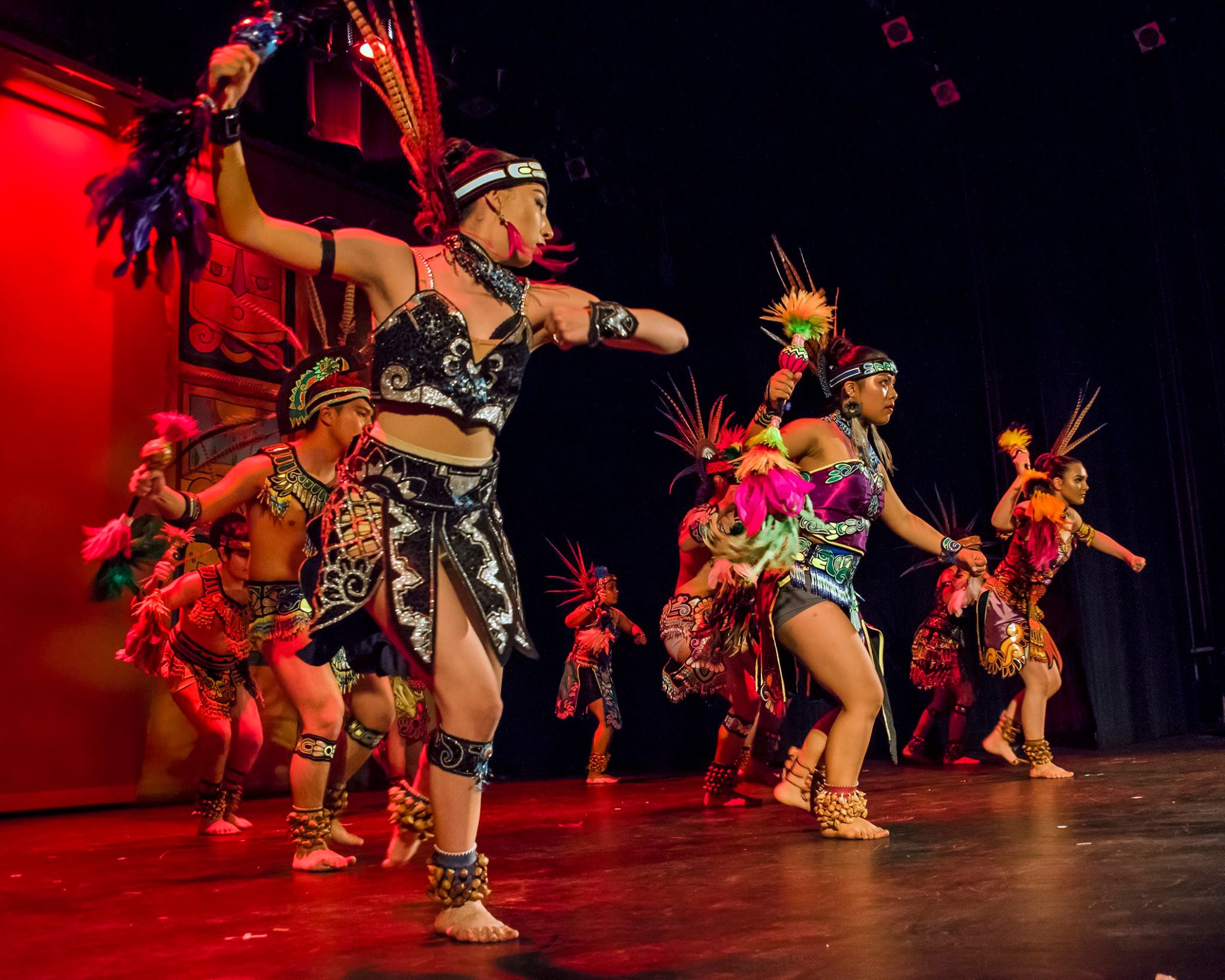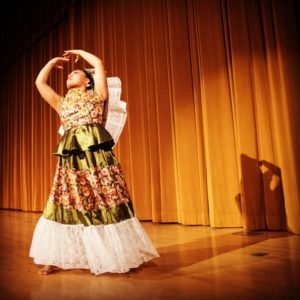
Photo by Sam Rodar
How many times has a dancer dreamed over a cup of tea at La Boheme? The cafe beneath Dance Mission Studio at 24th and Mission streets in San Francisco has hosted so many pre-class/post-class meet-ups among dancers that if its walls could speak, they would spin a tale of San Francisco’s dance community over the past twenty years rivaling any history the most attuned member of the dance community could recall. Dreams to movement, cultivated in conversation among friends and among community.
I met with Jesús Cortez at La Boheme on a cool summer morning to hear him describe how his dream came to be a reality in San Francisco. Jesús is the director and choreographer of Cuicacalli Dance Company and in that role he has manifested a dream that brought him here from Vera Cruz, Cancun and Mexico City, to Dallas/Fort Worth and New Mexico in the US, and finally to San Francisco, where he has built an artistic practice focused on both Ballet Folklórico and Contemporary Dance styles that he will be sharing with the community at the Rotunda Dance Series in San Francisco’s City Hall on Friday, September 6th.
The original dream, the childhood dream, as often is for young people around the world, was football. As a child in Vera Cruz, Jesús’ initial interest in footwork was contained to the soccer pitch, but from the age of six his mother “was very strict about me taking dance classes. I could do anything I wanted, but before I did anything else I had to go to classes every Monday, Wednesday, and Friday.” His teacher was his great grand uncle, Juan Natoli, who ran a dance academy in Vera Cruz named Cuicacalli. After 11 years of training with his uncle, Jesús moved to Cancun to dance there and began to envision a career as a professional dancer. This dream came closer to reality when he joined the Ballet Folklórico de México de Amalia Hernández. Based in Mexico City, the company is the most prestigious Ballet Folklórico company in the world. Performing with that company was a further advancement in Ballet Folklórico, but by virtue of being in Mexico City and touring to other international and cosmopolitan cities, he began to dream of working as a contemporary dancer as well as a traditional one.
That growing interest led to the decision to move to Dallas/Fort Worth to focus on contemporary dance. As his studies progressed he began to see contemporary dance as a practice that could exist in correlation with his Folklórico training, instead of in opposition to it. After a year or so in Texas, a friend convinced him to move to Santa Fe, New Mexico to teach dance in a public school. He reflects that “It was an opportunity, and it was a little challenging for me because at the time I was a full-time dancer and it wasn’t in my plans at that moment to start teaching.” He taught Ballet Folklórico in the schools, but also joined Moving People Dance Santa Fe to continue working on his contemporary vocabulary.
But teaching students in New Mexico brought forth a new dream for Jesús, one that re-connected him with his familial and artistic lineage. He realized that if he ”taught all these students [the same dances] I learned when I was a child I would be passing on all the learning that my great grand uncle gave me, that the most important things were hard work, discipline, commitment, and to respect the tradition and be true to our culture.” He firmly taps his hand on the table, continuing “that was the foundation, and without that foundation I wouldn’t be where I am as a dancer, as a choreographer, as a director. So I started teaching the students the way I learned as a child, and I liked the results, and I decided to continue being a teacher.” Eventually Moving People Dance Company’s members dispersed to larger cities where there were more opportunities for dance, and Jesús moved to San Francisco.
The dream was to live as a teacher and practitioner of dance; the work was intense and the progression slow. He danced for Printz Dance Project and took classes with Robert Moses among others, but his intention was to build an academy for dance. He recalls that he and his girlfriend at the time (now wife) were “flyering everywhere in the Mission and the Excelsior and throughout the city. We rented a studio and for the first two months I only had one student! But I kept going because if I had at least one student then I had school.” He moved to a new studio at the Katherine Michiels school on Guerrero Street where classes began to grow, and when he outgrew that space a friend introduced him to Brava for Women in the Arts, and their theater and studio spaces on 24th street in the Mission District.
He speaks of his experience at Brava with reverence: “It was something magical. I started renting the studio on Saturdays. Now Brava has been our home for the past 12 years.” Far gone are the days when Jesús kept the dream alive with just one student; today Jesús teaches eight classes a week for over 50 regular students and is an artist-in-residence at Brava. In the spring of each year, the entire company performs an annual production, “Tradición, Movimiento y Pasión” in Brava’s main theater. He was recently able to take Cuicacalli Dance Company on their first tour and a return to Santa Fe was one of the stops. He’s planning a tour in the future to take his company to Mexico and take his American students to Vera Cruz where his journey first began.
Jesús describes his school as a dance formation school where children as young as six begin with Ballet Folklórico and develop their skills over time in additional classes that include Hip-Hop and Contemporary dance. He is proud to share that over time they “now have a couple of generations of dancers who were dancing with me and are now dancing in professional level companies.” Furthermore, he continues, “the dance academy has been built in honor of my great grand uncle, with the name also being Cuicacalli—once again it means “House of Culture.” Other people know Cuicacalli as “House of Singing,” but because [the Cuicacalli] was the place where the Nahua children [the Nahua are an indigenous culture in Southern Mexico and Central America] would be sent to learn singing, dancing, and the arts I call it the House of Culture. Period.”

And it’s really a house of many cultures, according to Jesús “we don’t only do Ballet Folklórico from Mexico. We do Afro-Cuban, Afro-Nicaraguan, Afro-Peruvian, among other styles. We hire choreographers [from these traditions]. The vision of the school is to be an overall dance academy, not to be only one style. We also have a youth mariachi group. That’s why I call it Cuicacalli Dance company and not Ballet Folklórico Cuicacalli, which I do when we perform just Ballet Folklórico. But we have many branches.”
For Jesús, there’s a reward as a teacher, “but also as a carrier of the tradition of my great grand uncle. Sometimes when we are in other countries it’s very easy to lose [touch with culture] because there aren’t that many people who are passing it down.” He continues, “so even though I am not passing it down to my community in Mexico, I feel that my part of the tradition is to pass it down to the people who left Mexico and don’t have those outlets anymore.” That transference of tradition extends to his own family. His daughter is a member of the group, and his son is just about to start classes.
When I ask about his teaching, he shares that he “likes to see students who become professional dancers, but I also want to see students who don’t become professional dancers just become better people. I say that when I teach dance, I’m teaching life. Everything you do in dance classes is going to relate to what you’re going to be doing in the streets, what you’re going to be doing in a job. It’s all about the discipline, hard work, you know, the commitment.”
When I say he’s fulfilling his dreams, Jesús agrees, saying “It’s not very easy to find a job that you love, and right now I am doing that job, and I love it and I am passionate about it. And I’m looking for more, I have big dreams and I know the dreams will not happen unless you pursue them and take action.
When he brings his dancers to San Francisco City Hall for the Rotunda Dance Series, they will perform Ballet Folklórico Mexicano using style associated with several different states of Mexico. He also says that the company will perform a “Contemporary Aztec” dance, and I ask him to elaborate on what constitutes Contemporary Aztec.
Jesús explains that as a Mexican, he wants to “honor the indigenous cultures, and I feel that when it comes to those dance forms, if we aren’t doing them in the sacred spaces, it’s almost disrespectful if we do the dance as a ceremony. “So,” he continues, “I research all the different aspects of the ceremony and the dancing and from those traditional steps and movements.”
He says he creates “new movements based on the movements in an Aztec ceremony, but it’s not an Aztec ceremony, and I don’t claim that. You can see Aztec dancing in the streets because those groups have elders who form a circle and make it a ceremony. We don’t dance in the circle. We are putting on a show, and that makes it Contemporary Aztec. I also ask permission and talk to people and ask them for their advice to make sure I am respecting their culture. It’s a challenge for anybody who wants to do it, because you can cross the line very easily, most people won’t even notice, but the people who know will always let you know.”
We end our conversation by discussing the different staging possibilities available in the Rotunda’s space, and as he describes the possibilities, it appears that Jesús is staring into the wall beside us. I know he’s seeing a set of movements that will take place in the space of the Rotunda. He is dreaming of what a community looks like coming together in movement.
This article appeared in the September 2019 issue of In Dance.


